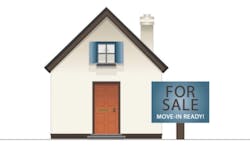Solving the Spec-Home Customer Satisfaction Dilemma
In a market where every house sold is critical, many home builders unconsciously make choices that cost them at least three to five sales annually for every hundred homes sold. Even more frustrating is the fact that generating those “lost” sales costs no more than what builders are currently spending.
As a home builder, I knew there was something significantly different about a customer buying a “to-be-built” home versus a completed-inventory home. Now, after 20 years of pondering this issue and armed with a new study from our database of well over half a million customer surveys, the truth can be told: there is a difference, but it’s not the customers. The difference is the builders. That’s right, while builders are well accomplished at building homes, they’re not quite as skilled at building relationships, especially with buyers of completed-inventory (aka spec) homes, losing 30 percent of their referring activity.
Even in today’s capital-restricted market, many home builders still rely on completed-inventory sales for profitability — selling 10 to 30 percent of their annual volume in pre-started (planned or cancellation) homes. A recent study of nearly 4,000 new-home buyers by Woodland, O’Brien and Scott revealed the undeniable fact that customers of to-be-built homes are significantly more satisfied than customers who bought a completed-inventory home. Why? Here are three reasons:
1. Less time for building client relationships
Home builders are highly systematic in their design, estimating, purchasing, and construction processes. No detail is overlooked, and they budget the sticks, bricks, and labor ad nauseam. They even budget “time” for homes and continuously evaluate and adjust construction schedules. They also budget time for customer interactions — about 30 hours worth on average for each home, including 16 hours of sales time (appointments, follow-up, contracts, etc.), six hours for design, and eight hours of superintendent time (pre-construction meeting, pre-drywall walkthrough, construction updates, and home presentation).
Similar to the construction schedule, these 30 hours should be viewed as client relationship-building time. Is it a surprise then that when a customer buys a completed-inventory home and is “shorted” these 30 hours, they are less satisfied with their home builder? Completed-inventory buyers are also less enthusiastic and less likely to refer family members or friends — and those that do refer fewer people. Our study shows that completed-inventory customers who receive only a small portion of the 30-hour relationship time are far less of a referral asset than to-be-built customers (see sidebar below).
2. Less time for customer education
Thirty hours is a lot of time to invest in a customer, don’t you agree? Clearly, these 30 hours are not spent chitchatting, but rather helping the customer understand the home builder’s philosophy, offerings, selections, construction techniques, schedule, etc. In other words, educating them. We all know that good teaching creates more learning. Did you know that the term “learning” comes from the Latin word “movere,” or to move, and its root is shared with the term “emotion”? In the book How We Decide, by Jonah Lehrer, the connection is made that when people learn they are more emotionally attached. So, the opposite would also be true — the less we teach the less emotionally attached a customer is to our company.
RELATED
- Mastering Customer Feedback—More Important Than Ever
- How Home Builders Can Deal With Difficult Customers
- How Do You Measure the Customer Experience?
This is why we measure customer enthusiasm using a proprietary algorithm to measure, benchmark, and manage how well a home builder’s time, education, attitude, and processes bond the customer to the home-building company. We know from statistical studies that a high willingness-to-refer rate is not enough to influence referral sales — it also requires a high customer enthusiasm rate for the referral to be effective. High willingness to refer is just that — willingness. Customer enthusiasm indicates the customer’s propensity to refer with the gusto necessary to influence the referee.
Most home builders have experienced how customers feel when the customer sees a “customization” in a neighbor’s home that they did not know was available. These customers feel short-changed, deceived, and even angry. The same can be said when customers hear neighbors talking about how great their selection appointments were or how much they liked (or even loved) their superintendent, who taught them about ground-fault interrupt outlets, energy savings features, emergency shut-offs, etc. When completed-inventory customers learn of all the special treatment, education, and bonding they missed, they often have those same short-changed, deceived, and angry feelings.
3. The sales process is strictly transactional
Here’s a test for your company: Do you have different names for your customers depending on what they’re shopping for or have purchased? I have heard many sales-office conversations between sales managers and salespeople where the to-be-built prospects are referred to by name (e.g., Mr. and Mrs. Wilson), and it’s known where the Wilsons work and how many children they have. On the other hand, a completed-inventory prospect is known as “the buyer for lot X,” “Realtor Sally’s client,” etc. I believe much of this attitudinal difference comes from the viewpoint that spec homes are cash-flow generators, leading to an attitude of “get me a buyer and let’s dump that spec” instead of a customer-centric perspective.
Too many home builders believe they are competing in two different markets. Their to-be-built business competes against other new-home builders, while their completed-inventory business competes against resale homes. This dual-market view leads many builders to treat their inventory buyers as resale buyers with the accompanying “what you see is what you get” mantra. Hardened by this resale philosophy, builders often give completed-inventory buyers less grace because “we discounted the heck out of that house.”
Clearly, price-centric negotiations can create an initial transactional relationship and leave both parties feeling some animosity over not getting what either fully wanted. For a healthier perspective, think of the discount not as a reduction in the price of the home, but rather a credit for the 30 hours of customer relationship and education that was budgeted but not included. Our study shows this initial transaction relationship must grow into a deeper, more meaningful builder-customer relationship to increase the customer’s future referrals.
How to infuse enthusiasm into spec-home customers
Regardless of to-be-built or spec, all customers in a neighborhood eventually have similar emotional expectations and would appreciate a great home and a positive relationship with their builder. The challenge is to quickly convert completed-inventory buyers into enthused, high-referring customers.
When a customer purchases a completed-inventory home, where does the budgeted relationship time go? Clearly, the same amount of time was spent building the home, yet those 30 hours of relationship building never occurred. On the construction side, if we are short a truss or a vendor puts in a lower-specification product, we generally become very, let’s say, inquisitive about this “slippage.” I advocate that we look at the 30 hours of relationship-building time similarly.
Furthermore, find a way to recreate the benefits of this 30-hour relationship/teaching investment to build higher customer-satisfaction rates. Here are five proven ways to recreate the to-be-built customer experience for inventory buyers:
1. Invite inventory customers to visit the design studio
Encourage completed-inventory customers to visit the showroom or meet with the designer who made their selections after they move into their home. The purpose is relationship building, but it also helps the customer understand the rationale for their finish selections (color palette, cabinet design, flooring selections, etc.). Make it fun and informative — for example, customers emotionally bond much better to a home with the “Americana motif” than “spec color package No. 2.”
Some builders are afraid of inviting spec customers into their selection center. They are fearful that these customers may want to change something. If the customer does want to install a new countertop six months after they move in, then put them in touch with your vendor. Or, better yet, introduce this customer to the idea of building a brand-new, personalized home especially for them.
2. Organize a pre-start meeting
Some savvy builders who understand this education-bonding dynamic re-create a “pre-start” meeting with their completed-inventory customers. At this meeting, they review key items like the floor plan, plot plan, and drainage pattern, and provide some history of the home’s construction, teach quality assurance practices, and demonstrate the onsite teamwork between the salesperson, superintendent, and warranty technician. This teaching and teamwork are extremely influential in developing a stronger buyer-builder emotional bond and are key factors in future referrals.
3. Offer a pre-drywall walkthrough with the superintendent
To recapture the construction education/relationship time, why not invite completed-inventory customers to a pre-drywall walkthrough of a nearby home? Showing these customers how the home was built behind the drywall and the quality assurance frame-check process tells these customers two things: that the superintendent is knowledgeable and he/she cares about the builder’s homes and customers. This alone could raise customer satisfaction and referral rates substantially.
4. Conduct a community orientation walk with the salesperson
The same can be said for involving the salesperson. After the completed-inventory customer moves in, why not tour the neighborhood, show the amenities, introduce the new customer to the neighbors, and “re-sell” the neighborhood location? Also, the salesperson should take the customer into the sales office and through the model home and emphatically encourage future visits with friends and family.
This one- to two-hour community orientation is the perfect time to plant the seed for referral sales, maybe even explain a referral program, and announce your desire to complete the neighborhood with family and friends. This community overview and referral message helps foster feelings of connectivity and pride in their neighborhood and gives the customer some selling points to share with family and friends.
5. Show spec buyers some love
Many builders have a customer communications plan (or CRM) which includes phone contacts, thank-you cards, welcome letters, congratulatory notes, homeowner binders, etc. But often they do not employ these relationship-building tools on customers who purchased past the point that we say “Thank You.” Unbelievable.
4 Keys to Growing Referrals From Spec-Home Customers
- Determine how much customer relationship time you have allocated in your home-building process. Develop strategies to maximize this relationship and educational time investment for both to-be-built and completed-inventory customers.
- Get rid of the buyer double-standard. Shift the company attitude to building communities and serving customers equally, regardless of the stage at which the home is purchased.
- Take a close look at the words and pronouns you use to describe your homes and customers.
- Treat all customers as to-be-built customers by purposefully building both a good home and a relationship. Doing so will unquestionably improve your overall customer willingness to refer, customer enthusiasm, referring activity, and referral sales. Plus, isn’t it simply the right thing to do?
About the Author

Charlie Scott
Charlie Scott has over 30 years of homebuilding industry experience including front line roles as new home Salesperson, Builder, Quality Assurance, VP of Operations and EVP/minority owner. As an industry consultant, he’s worked with hundreds of home builders to improve their operational excellence. He also has evaluated more than 40 home builders as a National Housing Quality Award (NHQA) Examiner and was inducted into the NHQA Hall of Fame.
